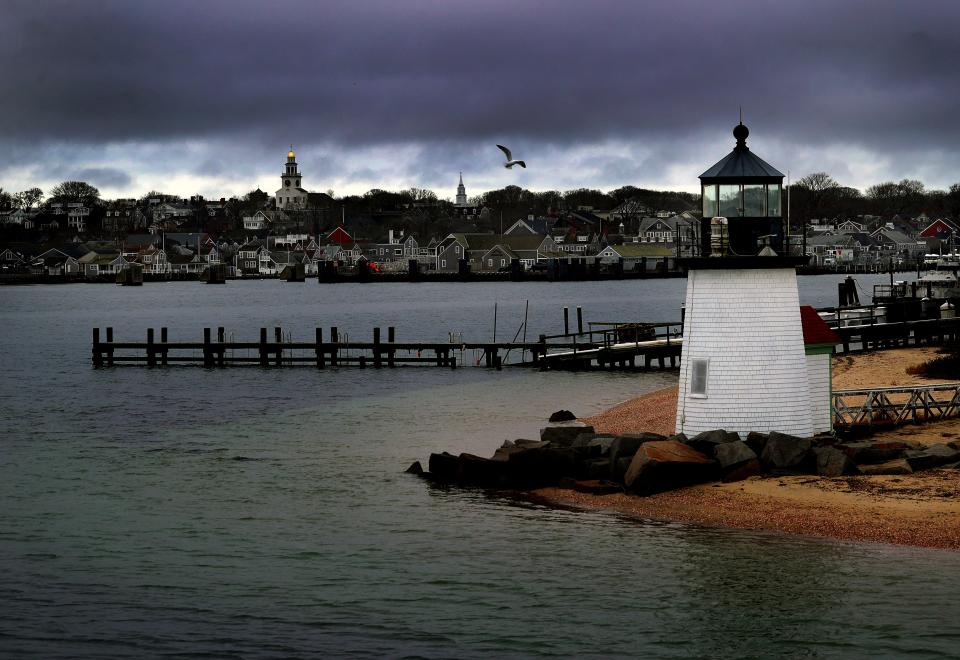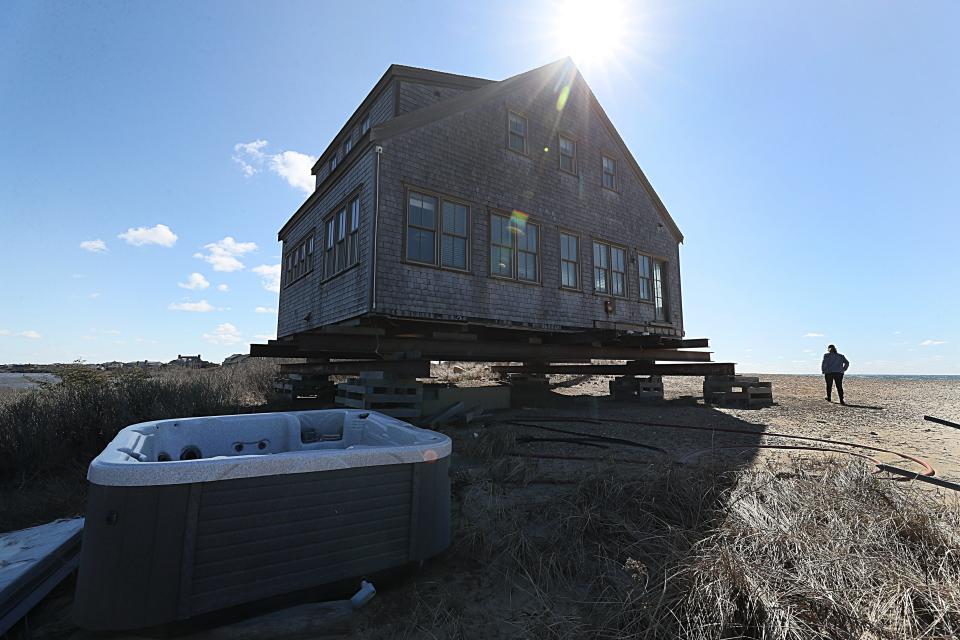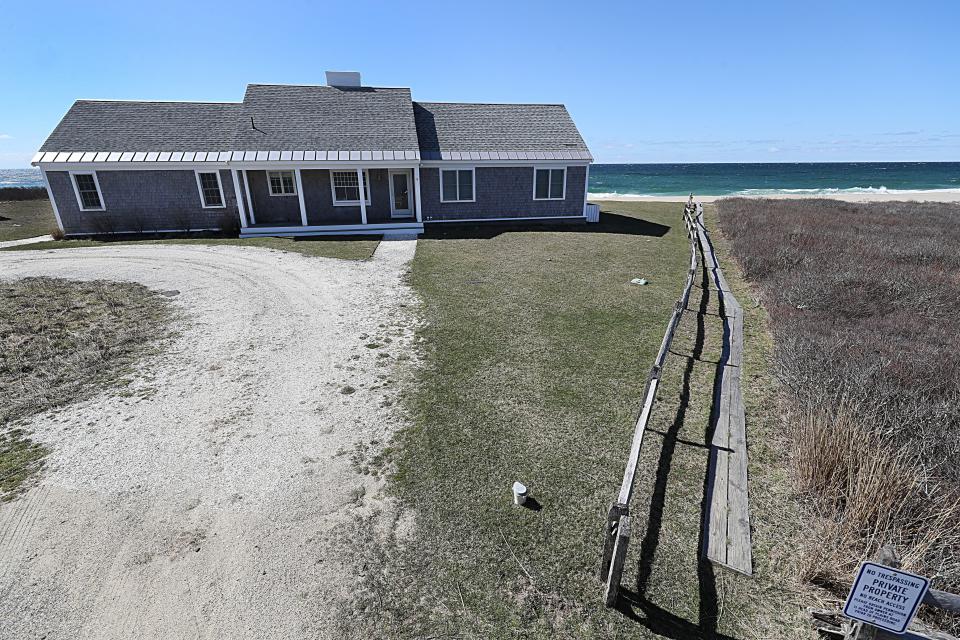Homes on billionaire hot spot Nantucket are falling into the ocean at an alarming rate — but the wealthy won't stop buying
- Oops!Something went wrong.Please try again later.
This month, residents of the island of Nantucket, a storybook New England coastal retreat located 30 miles off the coast of Cape Cod, gathered for their annual town meeting and quietly acknowledged a mounting eco-crisis.
Erosion, which is typical for most islands, is now increasing in severity, threatening to reshape Nantucket's downtown and wash away the homes sitting on its edge. Permanent residents formally approved the designation of the entire island as an "Islands Coastal Resilience District," with hopes that state-backed help could follow.
A lot of real estate value is at stake. Over the past two centuries, Nantucket has gone from a whaling town to a hippie refuge to a holiday hot spot for billionaires. Its year-round population hovers at about 14,000, but over the summer, it balloons to 80,000 as the likes of Blackstone's Steve Schwarzman and former Google CEO Eric Schmidt, who own picturesque grey-shingled mansions lined with blooming hydrangea, descend on the island in their private jets, sporting Nantucket red and boat shoes.
But a changing climate is exacerbating the ever-present threat of erosion, and it's claiming more victims. Last month, real estate investor Barry Sternlicht had to demolish his home to prevent it from falling into the ocean; others with valuable beachfront properties have paid millions to move their houses further away from the sandy coast.
And it's only expected to worsen in the "foreseeable future," C. Elizabeth Gibson, the town manager, wrote in the 2021 Coastal Resilience Plan. "The risks for Nantucket, a maritime community, are significant."

In total, sea level rise, coastal flooding, and erosion are estimated to cause over $3.4 billion in cumulative damages to Nantucket over the next five decades, according to the plan.
But demand for properties has remained sky-high on the idyllic island. Last year's median home sale price was $3.2 million, up from $1.9 million five years prior, according to data from local firm Fisher Real Estate. Twenty-seven percent of the homes sold cost more than $5 million.
"The concentration of wealth is quite stunning on Nantucket, and it keeps escalating," Bruce Percelay, a real estate developer and the publisher of the island's N Magazine, who has been vacationing on Nantucket for nearly all of his life, told Business Insider. "To use a well-worn phrase, come hell or high water, people are still buying multimillion-dollar homes on Nantucket."
The Grey Lady is only getting greyer
Year-round Nantucket resident and real estate broker Edward Sanford's family has been visiting the island for generations, starting in the 1920s. As a child, he'd visit his grandfather's cottage on the south shore, which has been prone to erosion for hundreds of years.
"We called it the shack. It had a handpump for plumbing and no electricity," he told BI. "That building today is probably two or three hundred yards into the ocean."
It seems that everyone with a connection to Nantucket knows someone who knows someone who has been affected by erosion or rising sea levels. The island is, as residents like to remind you, nothing more than a sandbar, and erosion was causing destruction long before terms like climate change were part of the common vernacular.
"If there was no global warming or there was no rising sea levels, storms happen, and waves lap against the land," Percelay said. "When the land is made of sand, it erodes, and it is hard to tell whether this would happen under different circumstances, but it is not a new condition." (Last year, Percelay garnered attention for clashing with a climate protester at a Nantucket cocktail party, something for which he has since apologized. Percelay told BI that his real estate development company has won awards for the application of green technology and that his Nantucket house is fully solar-powered.)
Still, all signs point to destruction intensifying with the changing climate.
Downtown's Easy Street flooded an average of six days a year between 1965 and 1972. From 2013 to 2020, that increased to an average of 37 days a year, and in 2023, it flooded 75 days, according to the town's coastal resilience department.
By 2070, over 2,300 buildings — 84% of the homes — on the island will be at risk of coastal flooding or erosion, according to projections from the Coastal Resilience Plan, created by the town in 2021 to outline the risks and propose interventions. Between 2030 and 2100, the number of structures exposed to coastal erosion is expected to go from 113 to 860.
Increased erosion puts multimillion-dollar homes at risk
Several expensive oceanfront neighborhoods — and the multimillion-dollar mansions within them — are particularly vulnerable.
"They're not your classic beach house. They're much more substantial," Greg Mckechnie, a real-estate agent who has lived on the island for 25 years, told BI. "When I was a kid, if a house flooded down on Hulbert Avenue, you'd go get a broom, sweep the water out, and wait for it to dry."

In the quiet area of Cisco, Sternlicht's home was recently demolished before it fell into the water. In nearby Madaket, famous for its untouched acres and beautiful sunsets, a number of houses have also suffered that fate.
Real estate broker Shelly Lockwood, who's lived on and off the island since the 1970s, recalled a client's parents being forced to tear down the home they'd lived in for decades.
"He was like, 'When we bought that house 47 years ago, my wife told me I would die before the house went in, and I'm still here,'" she recalled. "It's heartbreaking."
On the island's eastern side, Siasconset, called Sconset by locals, is known for its expensive homes and well-heeled inhabitants, and it's similarly in danger.
People buying on the area's Baxter Road often purchase property on either side of the street, with the parcel further inland serving as a sort of insurance policy — a place to move their homes if erosion comes for their beachfront. If a Baxter Road lot becomes completely inhabitable, one can do as a former Sconset resident did in 2010: cut the house into six pieces and move it to a completely different part of the island.
"Without erosion, this would be an extremely valuable area," Baxter Road resident Joshua Posner told BI. "With erosion, it's volatile."
Sankaty Head Beach Club in Sconset — part of a golf club where Jack Welch routinely played in tournaments and which reportedly counts former Patriots coach Bill Belichick as a member — received a demolition permit last month in the face of continued erosion. Real estate broker Sanford, who is the vice president and treasurer of the club's board, said the permit is more about preparedness and that the building won't be destroyed right away.
Still, a demo permit is notable. Demolition on the island is seen as a last resort. Legal measures ensure an owner has exhausted all other options — and indicate that if a structure stayed in place, it would actually be harmful.
"Once it's in pieces all over the place, and — pun intended — but once the septic falls in, it's a pretty shitty situation," Lockwood said.
'Leases with Mother Nature'
In February, a home on Madaket's Sheep Pond Road made headlines for its sale price: $600,000, down from its original price of $2.3 million. Sanford said the ranch-style three-bedroom property could have gone for as much as $12 million if not for the erosion that recently destroyed dozens of feet of its shoreline.
The house, Sanford added, "is not long for this world."
That's something its buyer, New Yorker Brendan Maddigan, seemed to be OK with.
"I'd like to think that it'll be there for a while, but I was definitely aware of the risk of any particular storm causing a problem in the future," Maddigan told The Boston Globe.
"Those are properties we refer to occasionally as leases with Mother Nature," real-estate agent Mckechnie told BI.

A few other sellers have similarly cut their listing prices. A nearby house on Sheep Pond Road is now going for $2.995 million, down from $3.998 million, and one on Sternlicht's street saw its price go from $5.6 million to $5.1 million earlier this month.
Some areas that are more impacted by rising sea levels than by erosion — like Brant Point, whose properties have pristine lawns and views of the Nantucket Sound — have become more expensive. In October 2021, Schwarzman bought a home in the neighborhood for $32.5 million. Last year, an unknown buyer purchased a house nearby for $33 million.
"When it comes to rising sea levels, the trade-off for the amenities, location, and often views, people are willing to take on the mitigation that needs to be done," Mckechnie said, like building at a higher level and adding storm panels.
Lockwood has made it her mission to ensure that homes on the island are priced fairly, in part to protect clients and in part to protect brokers' reputations.
"Some of these homes are extremely overvalued," she said. "We as a profession need to get in front of it, or we're all going down as sleazebags."
She's helped develop an education module for real estate agents on coastal resilience so they can fully understand the dangers of erosion and rising sea levels; once they know the risks — or "material defects" — agents will be obligated to disclose them to clients.
"I was watching people invest multi-millions of dollars on waterfront property, and I was like, 'Why? It's going in,'" she said.
Still, some wealthy people simply don't care to see the signs.
"Ultimately, the market makes the decision, not the real estate brokers," Percelay said.
Case in point: Last year's median home price in Madaket was $2.7 million — 39% more than the five-year average median price in the area, per Fisher's data.
Spending millions to keep erosion at bay
In Sconset, a group of neighbors have mounted a plan to buy themselves more time — and they are personally spending millions of dollars to do so.
With homes that hang precariously onto the edge of a 60-foot bluff, the residents of Baxter Road can't put their heads in the sand when it comes to the issue of erosion. Many, like housing developer Posner, have already spent tens of thousands of dollars to move their homes from their original positions.
"We're kind of sticking out farther into the Atlantic Ocean than anybody else," Posner, who moved his house back 50 feet 15 years ago, told BI.
Though the bluff has been eroding "irregularly" for the past 20 to 30 years, Posner estimated that sea level rise has accelerated the process to two to three feet every year.
So, he's taken action.
In the last decade, Posner spearheaded the implementation of anti-erosion technology called "geotubes." These large, cylindrical bags of sand that look like giant slugs are placed strategically on the shore to act as a defense barrier. The hope is that these structures will keep Baxter Road intact for decades.
The geotubes don't come cheap. Posner says current members of the Sconset Beach Preservation Fund, which manages the tubes, donate anywhere from $20,000 to $100,000 each year to the project. Not every resident of Baxter Road currently contributes, though Posner believes that will need to change if the plan is to be successful. Eventually, he estimates every owner will need to spend around $30,000 annually to keep the tubes operational.
"It's not inexpensive, but it is worth doing," Posner told BI. "It's like another tax bill."
Hedge fund pioneer F. Helmut Weymar, a Baxter Road resident who helped Posner research the geotubes, hopes they'll preserve the value of his five-bedroom home, which he spent $300,000 moving away from the bluff's edge six years ago. Purchased in the 1980s for $800,000, he believes with a successful geotubes project, the home's price could rise to $1.5 million.
However, the project has not been without controversy.
Advocates of the geotubes have been in a yearslong battle with the Conservation Commission of Nantucket, which says the tubes disturb the historic character of the beaches.
"Any attempts at delaying the impacts of erosion should rely on nature-based solutions," Coastal Conservancy member D. Anne Atherton told The New York Times in 2022.
To Weymar, the shorefront properties — which he pointed out supply the town with quite a lot of tax dollars — are as intrinsic to Nantucket as the beach is.
"The nature of Nantucket, to a significant degree, is the role of the summer community living on the shorefront," he said.
Posner, who said he believes an agreement will be reached with the Conservation Commission, is unwilling to wave the white flag to Mother Nature.
"If you have a chronic disease and the doctor tells you there's some things that can give you another 20 years," he said, "most people will take that."
Read the original article on Business Insider

